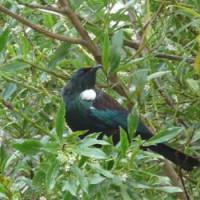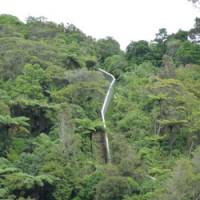A new year has begun, signs of change abound, and this column has migrated to a new page. The economic crises of 2008 are still with us and the nightmare of global climate shock is not one that we can awaken from. But among all this there are signs of hope.
A fellow naturalist and conservationist, Stephen Mills, has been inspired to write in the latest issue of the BBC's Wildlife magazine envisioning (at last) a brighter future for the tiger. I too would like to welcome this year on a positive note, with reflections on a very heartening experience in the suburbs of New Zealand's capital.
My sojourns in New Zealand are always tinged with mixed feelings: delight at its people, its scenery and its wildlife; despair at knowing just how much has been lost from this isolated ark in the millennium since Maoris, then Europeans, arrived on the scene.
The devastation caused by human hunting and habitat destruction, combined with the ravages of introduced alien predators (everything from cats to rats) to a land that had never been exposed to them, is enough to depress even an eternal optimist.
However, knowledge of what has been lost, and what still might be lost, has provided the necessary trigger that has stimulated an amazing effort by the N.Z. Department of Conservation and independent groups working in tandem with local multiethnic communities. Over recent decades, steps have been made to halt and reverse declines in endemic plants and wildlife, and one key strategy has involved the creation of offshore island sanctuaries. Where necessary, these have been first cleared of the various alien mammal pests introduced there. With the ground prepared, endangered species have then been reintroduced from surviving populations.
While many such sanctuaries have been completely closed conservation reserves, a number have been set up as open reserves to show and explain the vital work going on elsewhere, while also supporting conservation.
Among these consider Tiritiri Matangi Island, Motuara Island, and Ulva Island as must-see sanctuaries if you ever visit New Zealand.
Techniques for eradicating introduced aliens such as possums, rats and hedgehogs have been perfected over decades, and even larger offshore islands have been tackled and cleared of pests, thereby allowing native species to thrive. More recently, the big test has been to see whether ecological "island" sanctuaries could be set up on the mainland, where the array of alien species is greatest, but where the potential benefits are enormous: access for visitors; educational potential; the dream that New Zealand ecosystems of 200 or more years ago can be restored; the reality that such mainland sanctuaries form dispersal points for successful native species.
Late in 2008, I had the good fortune to visit friends in Wellington and to hear them enthusing about their local sanctuary. With a quick change to our plans I was able to visit the Karori Wildlife Reserve the following day,to learn the justification for their excitement. I was astonished at the wildlife that was thriving inside the sanctuary, astounded at how this had been achieved, and inspired because the same techniques offer hope to insular ecosystems around the world under threat — including those here in Japan, such as in Amami-oshima, northern Okinawa and parts of the Izu Islands.
Karori Wildlife Sanctuary, the model for my new inspiration, is a small protected area (225 hectares) in the suburbs of Wellington. Think of it as a small island; not one surrounded by water, but an ecological island surrounded by a fence. The area was previously the catchment area for two reservoirs, but when it was realized that a geological fault running through the area made the upper reservoir potentially dangerous (if its dam burst it would flood into the lower reservoir and would likely cause catastrophic failure of the lower dam and lead to flooding of parts of Wellington), it was decommissioned and drained and the area became available for other purposes. Thankfully, conservation won out.
Now Wellington has one of the most exciting wildlife sanctuaries in the world within its city limits.
The key to this extraordinary achievement is the pest-exclusion fence that now surrounds the reserve. Various materials and designs were researched, and studies of the threatening mammals revealed how high and how far they could jump or climb or burrow, and the effectiveness of various fence designs.
Once the 8.6-km fence was completed in 1999, the next goal was to eradicate all the mammalian pests inside. Those included: three rat species, mice, cats, dogs, pigs, deer, goats, hedgehogs, ferrets and possum. Removing them was an enormous task, but the fence has proved effective at keeping them all out.
The rodents are an often overlooked group of predators. We generally don't even think of them as such, but not only will they eat many of the indigenous large insects, they will also take bird and reptile eggs, and they are a serious predator of tree seeds.
The forest in the area of Karori was heavily degraded during the mid 1800s, then farmed until the early 1900s. Since then the forest has been regenerating, but the fence gave it a major boost, first through protection and second by selective planting of species that used to occur there.
I was amazed by the sanctuary's biodiversity. To understand its true significance you have to visit an unprotected forest near the city first to understand the contrast. Entering the reserve, the number of native birds is initially stunning — wonderful songsters and nectar-feeders such as Tui and New Zealand Bellbird abound. Overhead there are flights of Kaka (large native parrots) and displaying pairs of New Zealand Woodpigeon.
In the forest, endemic birds display the characteristics that were their undoing when non-native mammals were introduced — they are confiding and largely ground-dwelling. New Zealand Robins hop unconcerned around your feet, Tomtits forage through the bushes, and the fortunate may encounter a rare Saddleback or Stitchbird.
The reserve also protects other wildlife; Giant Weta and Maud Island Frogs have been translocated here. There are special "weta hotels," hidey holes for giant, hand-sized insects. Pride of place, though, goes to the prehistoric-looking tuatara, a primitive reptile that has outlived all other species in the Order Sphenodontia by 60 million years. Extinct on the mainland for centuries, it survived only on offshore islands. Exciting news broke last October when a nest was discovered at Karori. Individuals reintroduced there in 2005 and 2007 were definitely breeding — for the first time in more than 200 years!
Karori's tremendous success has inspired other projects throughout New Zealand, from Dunedin to Wanganui and from Christchurch to Waikato. The largest of them, the Maungatautari Restoration Project, now covers a whole mountain range (3,500 hectares). I can hardly wait to see an area of Yambaru in northern Okinawa protected in the same way — it would be an absolutely fantastic way of protecting the native flora and fauna from the ravages of introduced rats, cats and mongoose. Of course, the techniques would need some modification, because the area is home to several native small mammals, but these and the other native wildlife of the area would thrive without the impact of alien predators.
Am I dreaming? Maybe; but, if a country with a small population and a small tax base such as New Zealand can achieve so much, imagine what a powerhouse like Japan is capable of!
I dream of a future where people appreciate their dependence on the biosphere, and incorporate thoughts of environmental protection within their thoughts of self-preservation. And why not start a new year with big dreams?
Mark Brazil is a naturalist and author with a fascination for life in all its forms and the questions that it raises. His latest book, "Birds of East Asia" (a field guide that describes, illustrates and maps all of the birds of Japan, Taiwan and Korea and adjacent regions of China and Russia), has just been published by A & C Black and Princeton University Press. He welcomes questions or comments via sites.google.com/site/birdsofeastasia/





















With your current subscription plan you can comment on stories. However, before writing your first comment, please create a display name in the Profile section of your subscriber account page.